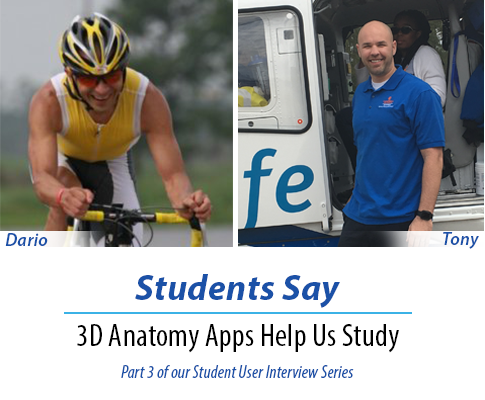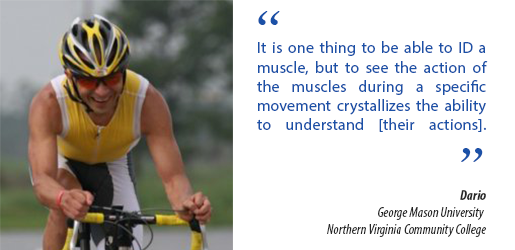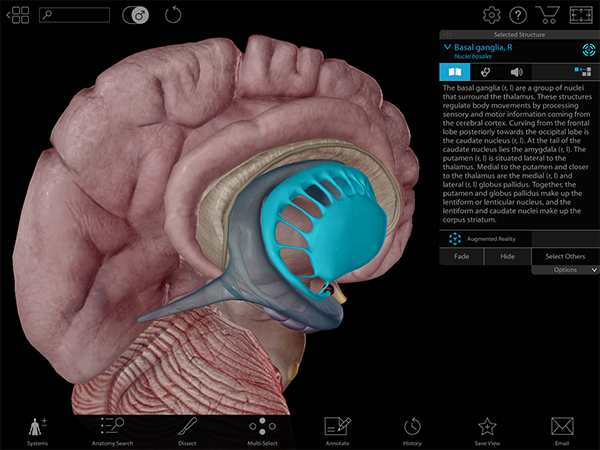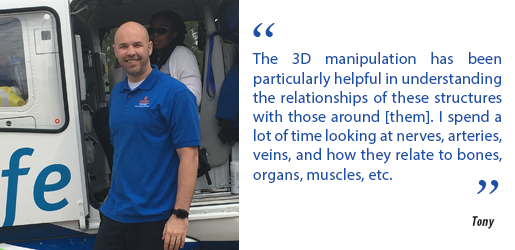Posted on 4/6/18 by Sofía Pellón
We’re back with more clever insights from students who use Human Anatomy Atlas as a learning tool—this time we’re going to hear about the study strategies that have helped them the most! We think you’ll learn something interesting from Dario and Tony, and we hope you’ll feel inspired to try something new with Atlas.
Dario is in the Athletic Training Education Program at George Mason University full time, in addition to being a part-time paramedic student at Northern Virginia Community College. His inspiration for studying health sciences is the combination of his love of anatomy, physiology, and medicine, and his desire to help people. Tony is in medical school, and he’s thinking of specializing in gastroenterology or another area of internal medicine. Tony chose this field because he loves physiology and discovering the processes that make the human body work.
Dario and Tony each connect with anatomy in a unique way using Atlas! We were excited to learn more about how they approach their studies, and we think you will be, too.
Dario: Having Atlas organized via body systems with the option to add in other systems and/or specific tissues (muscle, ligaments, organs, fat, etc.) really has helped me to better understand the specific structure I am viewing, as well as the specific structure's role overall in the human body. I also love that Atlas includes media sections with the muscle movements (just like in the Muscle Premium app). It is one thing to be able to ID a muscle, but to see the action of the muscles during a specific movement crystallizes the ability to understand [their actions].
I love the detail of bone markings in the skeletal system. For me, and I believe for any healthcare student, it's important to have an understanding for the details of the body's different systems. Depending on the healthcare student's specific area of study, the level of expertise will vary; however, having all those details from all the different systems available at the touch of a finger helps me (and other students) use [time more efficiently].

Tony: I love the ability to manipulate, remove, fade, and rotate structures to gain an understanding of their 3D structure. I cannot emphasize this enough. It is extremely useful to me.
I love using the skeleton to study osteology. It is extremely useful to focus in on a single bone and have the significant structures on that bone highlighted. Tubercles, grooves, condyles, etc.
Dario: I use Atlas to review concepts I learn in my classes and via my textbooks because it offers the ability to see details way beyond what I can see in a textbook or during lecture/lab presentations. Atlas also allows me to virtually dissect structures and view them in unlimited combinations and from multiple views, which is amazing. I love that Atlas is updated fairly regularly, which shows a great commitment to the product.
Tony: I already mentioned this, but 3D relationships are critical. Textbooks try, but they do not give a proper sense of the actual body. Additionally, I cannot possibly carry an anatomy book with me all the time. I have Atlas on my phone, iPad, and computer. I can look at it anytime and anywhere with ease. I commonly look at it during lectures when a question comes up about a particular structure. I am currently in a neuroanatomy course, and I have been using the various brain views and sections frequently, which is extremely helpful.
 A screenshot of a 3D brain model from Human Anatomy Atlas, highlighting the basal ganglia.
A screenshot of a 3D brain model from Human Anatomy Atlas, highlighting the basal ganglia.
Tony swears by a three-step lab routine:
1. I use Atlas frequently and follow a fairly specific process. First, I use it prior to any anatomy labs to learn where structures are likely to be located. I take the anatomical terms that I am supposed to learn and find them in Atlas. The 3D manipulation has been particularly helpful in understanding the relationships of these structures with those around [them]. I spend a lot of time looking at nerves, arteries, veins, and how they relate to bones, organs, muscles, etc.
2. I go into the anatomy lab and dissect the cadaver. I use the knowledge I gained from Atlas to locate the actual structures on the body.
3. I use Atlas to quiz myself after the lab. I use the quiz feature, and I also quiz myself. Many times, my study group will put the image on a TV so we can all discuss the structures and quiz each other. All of the students I study with are now using the Visible Body Atlas on their own as well. It has been very effective for learning outside the anatomy lab.

We hope you’ve enjoyed reading about Dario and Tony’s study strategies, and we hope you’re excited to try something new with Human Anatomy Atlas—maybe take some quizzes with your study group, catch up on your bony landmarks, or give yourself some extra visual context during a lecture.
How do you use Human Anatomy Atlas as a study tool? Do you have a special tip you’d like to share? We’d love to hear about it in the comments!
Want more?
When you select "Subscribe" you will start receiving our email newsletter. Use the links at the bottom of any email to manage the type of emails you receive or to unsubscribe. See our privacy policy for additional details.
©2025 Visible Body, a division of Cengage Learning